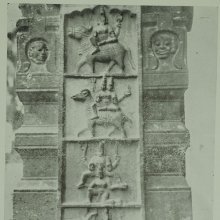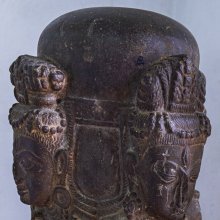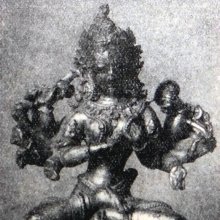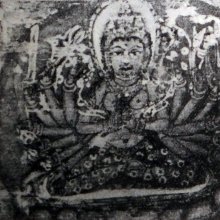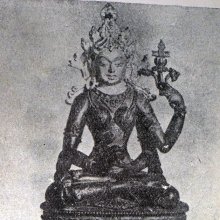Ishana, Īśānā, Īṣaṇa, Īsāna, Isana, Īśāna: 42 definitions
Introduction:
Ishana means something in Buddhism, Pali, Hinduism, Sanskrit, Jainism, Prakrit, Marathi, Hindi, biology. If you want to know the exact meaning, history, etymology or English translation of this term then check out the descriptions on this page. Add your comment or reference to a book if you want to contribute to this summary article.
The Sanskrit terms Īśānā and Īṣaṇa and Īśāna can be transliterated into English as Isana or Ishana, using the IAST transliteration scheme (?).
Alternative spellings of this word include Eshan.
Images (photo gallery)
(+1 more images available)
In Hinduism
Vaishnavism (Vaishava dharma)
Source: Google Books: The Fading Light of Advaita AcaryaAuthor of the Advaita Prakāśa. Īśāna Nāgara described himself as a young brahmin orphan, a servant in Advaita’s household and therefore someone who participated in the daily life of the family; he was initmately position to observe and report on what went on there. Īśāna has demonstrated that Advaita, as the embodiment of Mahāviṣṇu and Śiva, is divine. He has also shown that Sītā, like Rāma’s Sītā not born from a mortal womb, is Lakṣmī herself, the lotus-born goddess, whereas Śrī was born in the usual manner and is entirely human.

Vaishnava (वैष्णव, vaiṣṇava) or vaishnavism (vaiṣṇavism) represents a tradition of Hinduism worshipping Vishnu as the supreme Lord. Similar to the Shaktism and Shaivism traditions, Vaishnavism also developed as an individual movement, famous for its exposition of the dashavatara (‘ten avatars of Vishnu’).
Shilpashastra (iconography)
Source: Wisdom Library: Elements of Hindu Iconograpy1) Īśāna:—One of the five aspects of Śiva, known collectively as the Pañchabrahmās. They are emanations from the niṣkala-Śiva. Īśāna, according to the Rūpamaṇḍana, should have the colour as pure as that of the crystal; his head should be adorned with a jaṭāmakuṭa ornamented with the crescent moon and his hnads should have the akṣamālā, triśūla, kapāla and abhaya.
The Śrītatvanidhi gives somewhat different description. Īśāna should have, according to this work, five faces; each of these faces should have three eyes; the colour of Īśāna, should be white. This face ought to point to the top. Īśāna should have in his hands abhaya, varada (?) (iṣṭa in the original), aṅkuśa, pāśa, ṭaṅkā, kapāla, ḍhakka (a musical instrument), akṣamāla and śūla.
2) The deity Īśāna representing the Karmasāda has a perfectly white body resembling the flower of the kunda (a kind of jasmine) or the full moon; having five heads adorned with jaṭā-makuṭas; bearing on each face three eyes, ten arms and two legs. He is standing on a padmāsana and keeps in his right hands the śūla, paraśu, khaḍga, vajra and abhaya and in the left ones the nāga, pāśa, aṅkuśa, ghaṇṭa, and agni. He is beatiful adorned with all ornaments, draped in fine clothes and is with a smiling countenance full of peacefulness.
3) Īśāna (ईशान):—One of the eight names of Rudra, given to him by Brahmā, according to the Pādma-purāṇa. This aspect became the presiding deity over the fire. The corresponding name of the consort is Vikeśī. His son is called Lohitāṅga (Mars).
4) Īśāna (ईशान):—Fifth of the eleven emanations of Rudra (ekādaśa-rudra), according to the Aṃśumadbhedāgama and the Śilparatna. The images of this aspects of Śiva should have three eyes, four arms, jaṭāmakuṭas and be of white colour. It should be draped also in white clothes and be standing erect (samabhaṅga) on a padmapīṭha. It should be adorned with all ornaments and with garlands composed of all flowers and it should keep their front right hand in the abhaya and the front left hand in the varada poses, while it should carry in the back right hand the paraśu and in the back left hand the mṛga.
5) Īśāna (ईशान):—Third of the twelve emanations of Rudra, according to the Rūpamaṇḍana.
Source: Shodhganga: The significance of the mūla-beras (śilpa)Īśāna (ईशान) is one of the Aṣṭadikpālaka (“eight guardians of the directions”), as defined according to texts dealing with śilpa (arts and crafs), known as śilpaśāstras.—In dance, when the right hand of the dancer assumes arāla-hasta and the left hand of the dancer assumes ardhapatāka-hasta, it is vāyu-hasta. In dance the īśāna-hasta is found in śaiva-sthānaka posture with the right hand in tripatāka-hasta and the left hand muṣṭi-hasta obliquely (across). In images, Īśāna is found with a trident and a drum in the right and the left hands respectively. This posture of the hand in dancing and in the image is somewhat similar. The tripatāka-hasta / kartarīmukha-mudrā used in dance can depict holding the trident and the muṣṭi-mudrā can depict as if holding the drum. Hence, there is similarity in dance and image while depicting Īśāna.

Shilpashastra (शिल्पशास्त्र, śilpaśāstra) represents the ancient Indian science (shastra) of creative arts (shilpa) such as sculpture, iconography and painting. Closely related to Vastushastra (architecture), they often share the same literature.
Purana and Itihasa (epic history)
Source: archive.org: Puranic EncyclopediaĪśāna (ईशान).—(ŚIVA). Īśāna, with matted hair rides on the ox. See under Śiva. (Agni Purāṇa, Chapter 51).
Source: archive.org: Shiva Purana - English TranslationĪśāna (ईशान) is used as an epithet for Śiva, according to the Śivapurāṇa 2.2.41.—Accordingly, as Viṣṇu and others eulogized Śiva:—“[...] obeisance to Vāma, Vāmarūpa, Vāmanetra, Aghora, the great lord and the Vikaṭa. Obeisance to Tatpuruṣa, to Nātha, the ancient Puruṣa, the bestower of the four aims of life, Vratin, and Parameṣṭhin. Obeisance to you, Īśāna, Īśvara, Brahman, of the form of Brahman, the Supreme Soul”.
Source: Cologne Digital Sanskrit Dictionaries: The Purana Index1a) Īśāna (ईशान).—A boundary hill of Śākadvīpa.*
- * Bhāgavata-purāṇa V. 20. 26.
1b) (Īśa)—a name of Śiva;1 lord of the N. E.;2 the fourth body of Vāyu or the five vital airs; wife Śivā; son, Manojava and Avijñānagati.3
- 1) Brahmāṇḍa-purāṇa III. 24. 4; 73. 1; IV. 20. 51; 34. 91; 41. 6; Viṣṇu-purāṇa I. 8. 6.
- 2) Vāyu-purāṇa 108, 32.
- 3) Vāyu-purāṇa 27. 12, 32, 52; Brahmāṇḍa-purāṇa II. 10. 11, 41 and 79.
1c) The name of the tenth Kalpa.*
- * Matsya-purāṇa 290. 5.
Īśāna (ईशान) refers to the name of a Tīrtha (pilgrim’s destination) mentioned in the Mahābhārata (cf. III.83.25, XIV.8.27, XIV.8). Note: The Mahābhārata (mentioning Īśāna) is a Sanskrit epic poem consisting of 100,000 ślokas (metrical verses) and is over 2000 years old.
Source: Shodhganga: The saurapurana - a critical study1) Īśana (ईशन) is the deity to be worshipped in the month Kārttika for the Anaṅgatrayodaśī-Vrata, according to the 10th century Saurapurāṇa: one of the various Upapurāṇas depicting Śaivism.—Accordingly, the Anaṅgatrayodaśī-vrata is observed in honour of Śiva for acquiring virtue, great fortune, wealth and for destruction of sins [...] This vrata is to be performed for a year from Mārgaśīra.—In the month of Kārttika the performer should worship Īśana, drinking pañcagavya only once and gets the reward of agniṣṭoma.
2) Īśana (ईशन) refers to one of the names for the “sun” [viz., Sūrya], according to the eulogy of the Sun by Manu in the SaurapurāṇaŚaivism.—Accordingly, the Saurapurāṇa which is purely a Śaivite work, though it purports to be revealed by the Sun, contains some references to practices of Saura Sects, and here and there it identifies Śiva with the Sun. From the eulogy of the Sun by Manu it appears that the sun is the Supreme deity. [...] In another passage Manu while eulogizing the Sun god expresses that the Sun is another form of Lord Śiva. The sun is also stated to be [viz., Īśāna] [...].

The Purana (पुराण, purāṇas) refers to Sanskrit literature preserving ancient India’s vast cultural history, including historical legends, religious ceremonies, various arts and sciences. The eighteen mahapuranas total over 400,000 shlokas (metrical couplets) and date to at least several centuries BCE.
Shaivism (Shaiva philosophy)
Source: Wisdom Library: ŚaivismĪśana (ईशन) is the Sanskrit name of a deity presiding over Kedāra, one of the sixty-eight places hosting a svāyambhuvaliṅga, which is one of the most sacred of liṅgas according to the Śaivāgamas. The list of sixty-eight svāyambhuvaliṅgas and presiding deities (e.g., Īśana) is found in the commentary on the Jirṇoddhāra-daśaka by Nigamajñānadeva. The word liṅga refers to a symbol used in the worship of Śiva and is used thoughout Śaiva literature, such as the sacred Āgamas.
Source: Shodhganga: Iconographical representations of ŚivaĪśāna (ईशान) refers to one of the five faces of Sadāśiva that revealed the Āgamas (sacred texts).—According to the sṛṣṭikrama method mentioned in the Uttarakāmikāgama, “Kāmikāgama, Yogajāgama, Cintyāgama, Kāraṇāgama and Ajitāgama are emanated from the Īśāna face of Sadāśiva”. According to the saṃhārakrama mentioned in the Pūrvakāraṇāgama, “Prodgītāgama, Lalitāgama, Siddhāgama, Santānāgama, Śarvoktāgama, Pārameśvarāgama, Kiraṇāgama and Vātulāgama are from the face called Īśāna”.
According to the Ajitāgama and Rauravāgama, “Kāmika, Yogaja, Cintya, Karaṇa, Ajita, Dīpta, Sūkṣma, Sahasra and Suprabheda are emanated from the Īśāna face of Śiva”. Addionally, according to the Ajitāgama, “Their Upāgamas and the four Vedas along with the Vedāṅgas are emanated from the Urdhva (Īśāna) face of Śiva”.

Shaiva (शैव, śaiva) or Shaivism (śaivism) represents a tradition of Hinduism worshiping Shiva as the supreme being. Closely related to Shaktism, Shaiva literature includes a range of scriptures, including Tantras, while the root of this tradition may be traced back to the ancient Vedas.
Shaktism (Shakta philosophy)
Source: Wisdom Library: ŚāktismĪśāna (ईशान) refers to one of the 53 gods to be worshipped in the eastern quarter and given pāyasa (rice boiled in milk) according to the Vāstuyāga rite in Śaktism (cf. Śāradātilaka-tantra III-V). The worship of these 53 gods happens after assigning them to one of the 64 compartment while constructing a Balimaṇḍapa. Vāstu is the name of a prodigious demon, who was killed by 53 gods (e.g., Īśāna).

Shakta (शाक्त, śākta) or Shaktism (śāktism) represents a tradition of Hinduism where the Goddess (Devi) is revered and worshipped. Shakta literature includes a range of scriptures, including various Agamas and Tantras, although its roots may be traced back to the Vedas.
Vastushastra (architecture)
Source: Brill: Śaivism and the Tantric Traditions (architecture)Īśāna (ईशान) [=Īśānī?] refers to the “north-eastern” (direction), according to the Devyāmata (chapter 105).—Accordingly, [while describing the layout of the residence (gṛha) for the prāsādāśramin]—“[...] The residence for those who come to the temple is described in due sequence. In the southeast is the kitchen. In the northeast (īśānī—īśānyāṃ) is the space for worship. [...]”.

Vastushastra (वास्तुशास्त्र, vāstuśāstra) refers to the ancient Indian science (shastra) of architecture (vastu), dealing with topics such architecture, sculpture, town-building, fort building and various other constructions. Vastu also deals with the philosophy of the architectural relation with the cosmic universe.
General definition (in Hinduism)
Source: Wisdom Library: HinduismĪśāna (ईशान, “the ruler”):—In Vedic hinduism, he is the regent of the north-eastern direction and represents the embodiment of all learning and the master of all knowledge.
According to Vāstuśāstra, the north-eastern direction is the most important of all directs being ruled by Lord Śiva in the form of Īśāṇa. Prāṇa enters into the house from the Īśāna corner and exits via Nirṛti (south western) corner.
Source: Apam Napat: Indian MythologyIshana (ईशान) is one of the Lokapalas, and guards the north-eastern hemisphere, which duty he inherited from Soma. He is considered an incarnation of Lord Shiva, and is also known as Sthanu (स्थाणु), and Jishnu (जिष्णु).
Source: Universal Yoga: The Five Faces of ShivaĪshāna is the upper or skyward face. It is the Citta Shaktī or power of the individual consciousness to realize the universal consciousness. This form is associated with Akasha or ether, and the Vishuddha chakra. This is the total energy of Shiva encompassing all attributes of Shiva. This is the face of Shiva that is the revealing power and is associated with the Anandamaya kosha.
Source: WikiPedia: Hinduism1) Īśāna: Represents the Citta Śaktī of Śiva. Sāmbā Pīṭham. Represents Space. Starts from your Mūlādhāra to Anahata to Ajna to Sahasrara leading to Brahma Randra in your body. One billion (100,00,000) mantras are trying to describe this face of Śiva. Ākāśa (Ether) Tattva. The individual is from very less to not at all receptive to social structures. Possesses excellent qualities of controlling mortal and divine beings with ease. The individual has reduced his ego to ashes signifying absolute love for the universe and has been freed from cosmic law.
2) (fifth face of Shiva) - Īśāna - Revealing Grace. North-east. Ether (Ākāśa).
According to Śaiva Agama, Lord Shiva performs five actions - creation, preservation, dissolution, concealing grace, and revealing grace. Each of the five actions corresponds to a name and form of Shiva with varying attributes.
In Buddhism
Theravada (major branch of Buddhism)
Source: Pali Kanon: Pali Proper NamesOne of the chief devas.
In the Tevijja Sutta (D.i.244) he is mentioned with Indra, Soma, Varuna, Pajapati and Brahma, as being invoked by the brahmins.
He was in the battle of the devas against the Asuras and led a section of the deva host. Indra tells the devas that if, during the struggle, they felt faint hearted, they should look at the crest of his own banner or at that of Pajapati, Varuna or Isana, and their fear would disappear (S.i.219).
In the assembly of the gods, Isana gets the fourth seat next to Varuna. He is in beauty and longevity equal to Indra (SA.i.262).
Isana is an older name for Rudra (Siva) (Bothlinck and Roth: Worterbuch). The conception of him had so far changed by the time of Buddhaghosa that in Buddhaghosas accounts he is given a seat near Sakka and inferior to his. Perhaps he was one of the thirty three gods of Tavatimsa (KS.i.281, n.4).
Theravāda is a major branch of Buddhism having the the Pali canon (tipitaka) as their canonical literature, which includes the vinaya-pitaka (monastic rules), the sutta-pitaka (Buddhist sermons) and the abhidhamma-pitaka (philosophy and psychology).
Tibetan Buddhism (Vajrayana or tantric Buddhism)
Source: Wisdom Library: Tibetan BuddhismĪśāna (ईशान) is the name of a deity summoned by the Yamāntaka-mantra and mentioned as attending the teachings in the 6th century Mañjuśrīmūlakalpa: one of the largest Kriyā Tantras devoted to Mañjuśrī (the Bodhisattva of wisdom) representing an encyclopedia of knowledge primarily concerned with ritualistic elements in Buddhism. The teachings in this text originate from Mañjuśrī and were taught to and by Buddha Śākyamuni in the presence of a large audience (including Īśāna).
Source: Google Books: VajrayoginiĪśāna (ईशान).—Protector deity of the north-eastern cremation ground.—The northeast (aiśānī) is associated with Śiva, hence Īśāna also appears as Nīlalohita (Guhyasamayasādhanamālā 34), a synonym of Śiva in epic and Purāṇic tales, and Kapālīśa (Śmaśānavidhi 12). He is described as white, carrying a trident (śūlī), mounted on a bull, and wearing a tiger-skin.
Source: archive.org: The Indian Buddhist IconographyĪśāna (ईशान) (direction: Īśāna-corner) refers to one of the eight Dikpālas, commonly depicted in Buddhist Iconography, and mentioned in the 11th-century Niṣpannayogāvalī of Mahāpaṇḍita Abhayākara.—His Colour is white; his Vehicle is the bull; he has two arms
Īśāna is described in the Niṣpannayogāvalī (dharmadhātuvāgīśvara-maṇḍala) as follows:—
Source: Wisdomlib Libary: Vajrayogini“In the Īśāna corner there is Īśāna riding on a Bull. He is white in colour and holds in his two hands the triśūla (trident) and the kapāla (skull-cup). On his matted hair appears the half-moon, on his body a sacred thread of serpent and his throat is blue”.
[As Īśāna he is not represented in the Chinese collection].
Īśana (ईशन) is the name of the protector (dikpati) associated with Aṭṭaṭṭahāsa: the north-eastern cremation ground (śmaśāna) according to the Vajravārāhī-sādhana by Umāpatideva as found in te 12th century Guhyasamayasādhanamālā. As a part of this sādhana, the practicioner is to visualize a suitable dwelling place for the goddess inside the circle of protection which takes the form of eight cremation grounds.
These protectors (e.g., Īśana) are variously known as dikpati, dikpāla and lokāpala and can be traced to purāṇic legends where eight protectors are assigned to each direction by Brahmā. According to the Śmaśānavidhi verse 20, these protectors are in union with their wives and have four arms, two of which make the añjali gesture of obeisance, while the second pair usually holds a skull bowl and a tantric weapon. They are variously depicted upon their respective mounts, or sitting at the base of the tree.
Source: academia.edu: The Structure and Meanings of the Heruka MaṇḍalaĪśāna (ईशान) refers to one of the eight direction-guardians (dikpāla) of the Guṇacakra, according to the 10th century Ḍākārṇava chapter 15. Accordingly, the guṇacakra refers to one of the four divisions of the sahaja-puṭa (‘innate layer’), situated within the padma (lotus) in the middle of the Herukamaṇḍala. Īśāna is associated with the charnel grounds (śmaśāna) named Aṭṭahāsa; with the tree (vṛkṣa) named Vaṭa; with the serpent king (nāgendra) named Mahāpadma and with the cloud king (meghendra) named Ghana.
Source: MDPI Books: The Ocean of HeroesĪśāna (ईशान) refers to a deity associated with the guṇacakra or ‘merit circle’, according to the 10th-century Ḍākārṇava-tantra: one of the last Tibetan Tantric scriptures belonging to the Buddhist Saṃvara tradition consisting of 51 chapters.—Accordingly, [while describing the Merit Circle (guṇacakra)]: “[...] In addition, there are trees, the guardians of direction (dikpāla), serpent kings, and cloud kings in order—[...] [The guardians of direction are] (1) Indra, (2) the wealth-giver (Kubera), (3) the Lord of Nāgas (Varuṇa), (4) Yama the Lord, (5) Īśāna, (6) the fire (Agni), (7) Rākṣasa the king, and (8) the Lord of wind (Vāyu). [...] All is here in the charnel grounds; he should give a wreath of vajras [to them] All is also to be done in this same [charnel ground]. [All is] taught to be both external and internal. The Merit Circle, the third, is thus [taught]”.

Tibetan Buddhism includes schools such as Nyingma, Kadampa, Kagyu and Gelug. Their primary canon of literature is divided in two broad categories: The Kangyur, which consists of Buddha’s words, and the Tengyur, which includes commentaries from various sources. Esotericism and tantra techniques (vajrayāna) are collected indepently.
General definition (in Buddhism)
Source: Wisdom Library: Dharma-samgrahaĪśāna (ईशान) refers to the fifth of the “eight world protectors” (aṣṭalokapāla) as defined in the Dharma-saṃgraha (section 8). The Dharma-samgraha (Dharmasangraha) is an extensive glossary of Buddhist technical terms in Sanskrit (e.g., aṣṭalokapāla and Īśāna). The work is attributed to Nagarguna who lived around the 2nd century A.D.
Īśāna is, besides one of the “eight world protectors” (aṣṭalokapāla), one of the “ten world protectors” (daśalokapāla) and one of the “fourteen world protectors” (caturdaśalokapāla).
In Jainism
General definition (in Jainism)
Source: archive.org: The Jaina IconographyĪśāna (ईशान) refers to one of the Dikpāla or “guardians of the quarters”, a class of deities within Jainism commonly depicted in Jaina art and iconography.—Īśāna, the Guardian-god of the North-east quarters is to be represented according to the Śvetāmbara texts as riding a bull (joined by Umā), holding a bow and trident. He also bears matted hair and snakes on his person. The Digambara books mention only the symbols of a skull over and above the above-named characteristics.
Source: academia.edu: Tessitori Collection IĪśāna (ईशान) or Īśānakūṇi refers to one of the corners (kūṇi) of the samavasaraṇa (sacred space), according to the Golerā temple (Kumalgadh, Udaipur State), which has labels following the same lines as the Samavasaraṇastotra and the Dvādaśaparṣad, both texts dealing with the directions or the ‘corners’ (kūṇi) where the groups of beings (Parṣad) attending the samavasaraṇa sacred space have to sit or stand. The Golerā temple specifies how many figures of each category have to be depicted, e.g., the īśāna-kūṇi:—10 parṣada Vaimānikadevānāṃ 4 rūpa, 11 parṣada manuṣyānāṃ 4 rūpa, 12 parṣada mānuṣīstrīṇāṃ 4 rūpa.

Jainism is an Indian religion of Dharma whose doctrine revolves around harmlessness (ahimsa) towards every living being. The two major branches (Digambara and Svetambara) of Jainism stimulate self-control (or, shramana, ‘self-reliance’) and spiritual development through a path of peace for the soul to progess to the ultimate goal.
Biology (plants and animals)
Source: Google Books: CRC World Dictionary (Regional names)Ishana in India is the name of a plant defined with Prosopis cineraria in various botanical sources. This page contains potential references in Ayurveda, modern medicine, and other folk traditions or local practices It has the synonym Adenanthera aculeata (Roxb.) W. Hunter (among others).
Example references for further research on medicinal uses or toxicity (see latin names for full list):
· Fl. Pres. Madras (1919)
· Australian Journal of Botany (1997)
· Mantissa Plantarum (1767)
· Flora Indica (1768)
· Regnum Vegetabile, or ‘a Series of Handbooks for the Use of Plant Taxonomists and Plant Geographers’ (1993)
· Species Plantarum (1753)
If you are looking for specific details regarding Ishana, for example chemical composition, health benefits, pregnancy safety, extract dosage, side effects, diet and recipes, have a look at these references.

This sections includes definitions from the five kingdoms of living things: Animals, Plants, Fungi, Protists and Monera. It will include both the official binomial nomenclature (scientific names usually in Latin) as well as regional spellings and variants.
Languages of India and abroad
Marathi-English dictionary
Source: DDSA: The Molesworth Marathi and English Dictionaryīṣaṇā (ईषणा).—f (S) Wish, desire, regard; care or concern about; anxiety or earnestness for. Ex. of comp. lōkēṣaṇā, putrēṣaṇā, vittēṣaṇā, dārēṣaṇā.
Marathi is an Indo-European language having over 70 million native speakers people in (predominantly) Maharashtra India. Marathi, like many other Indo-Aryan languages, evolved from early forms of Prakrit, which itself is a subset of Sanskrit, one of the most ancient languages of the world.
Sanskrit dictionary
Source: DDSA: The practical Sanskrit-English dictionaryĪśana (ईशन).—[īś-lyuṭ]
1) Commanding, reigning &c.
2) Greatness, glory; एतदीशनमीशस्य प्रकृतिस्थोऽपि तद्गुणैः (etadīśanamīśasya prakṛtistho'pi tadguṇaiḥ) Bhāgavata 1.11.38.
Derivable forms: īśanam (ईशनम्).
--- OR ---
Īśāna (ईशान).—a. [īś tācchīlye cānaś]
1) Owning, possessing, master or lord.
2) Reigning, ruling.
3) Wealthy, rich.
-naḥ 1 A ruler, master, lord; ईशानो भूतभव्यस्य (īśāno bhūtabhavyasya) Kaṭh. Up.4.12.
2) Name of Śiva; ईशानसंदर्शनलालसानाम् (īśānasaṃdarśanalālasānām) Kumārasambhava 7.56; K.1.
3) The Ārdrā Nakṣtra.
4) One of the Rudras.
5) The number 'eleven'.
6) The sun as a form of Śiva. पर्जन्यो यमो मृत्युरीशानः (parjanyo yamo mṛtyurīśānaḥ) Bṛ. Up.1. 4.11.
7) A Sādhya.
8) Name of Viṣṇu.
-nī Name of Durgā.
-nī, -naḥ The silk-cotton tree (śālmalī; Mar. sāṃvarī).
-nam Light, splendour.
--- OR ---
Īṣaṇa (ईषण).—a. Hastening.
-ṇā Haste, speed.
See also (synonyms): iṣāṇan.
Source: Cologne Digital Sanskrit Dictionaries: Edgerton Buddhist Hybrid Sanskrit DictionaryIṣāṇa (इषाण).—m., name of a region, in the south: Gaṇḍavyūha 115.1 dakṣiṇāpatha °ṇo nāma janapadas; 116.3.
Source: Cologne Digital Sanskrit Dictionaries: Shabda-Sagara Sanskrit-English DictionaryĪśāna (ईशान).—m.
(-naḥ) 1. A name of Siva. 2. Also of the same deity as regent of the north-east quarter. 3. One of the Rudras. 4. The sun as a form of Siva. mf. (-naḥ-nī) The silk cotton tree, (Bombax heptaphyllum.) n.
(-naṃ) Light, splendor. f. (-nī) A name of Durga. E. īśa a master, &c. and ānac affix, and fem. ṅīṣ.
Source: Cologne Digital Sanskrit Dictionaries: Benfey Sanskrit-English DictionaryĪśāna (ईशान).—[īś + āna] (properly the ptcple. of the pres.), I. adj Raling,
Īśana (ईशन).—[neuter] power, dominion.
--- OR ---
Īśāna (ईशान).—[adjective] owning, disposing of ([genetive] or [accusative]), able; [masculine] ruler, sovereign; [Epithet] of Śiva & other gods. [feminine] īśānā [Epithet] of Durgā.
--- OR ---
Īśāna (ईशान).—[adjective] owning, disposing of ([genetive] or [accusative]), able; [masculine] ruler, sovereign; [Epithet] of Śiva & other gods. [feminine] īśānā [Epithet] of Durgā.
Source: Cologne Digital Sanskrit Dictionaries: Aufrecht Catalogus CatalogorumĪśāna (ईशान) as mentioned in Aufrecht’s Catalogus Catalogorum:—son of Dhanaṃjaya, brother of Paśupati and Halayudha: Dvijāhnikapaddhati. Quoted in Brāhmaṇasarvasva.
Source: Cologne Digital Sanskrit Dictionaries: Monier-Williams Sanskrit-English Dictionary1) Īśana (ईशन):—[from īś] n. commanding, reigning, [Śvetāśvatara-upaniṣad]
2) Īśāna (ईशान):—[from īś] īśāna (and īśāna) mfn. owning, possessing, wealthy
3) [v.s. ...] reigning, [Ṛg-veda; Atharva-veda; Vājasaneyi-saṃhitā; Śatapatha-brāhmaṇa] etc.
4) [v.s. ...] m. a ruler, master, one of the older names of Śiva-Rudra, [Atharva-veda; Vājasaneyi-saṃhitā; Śatapatha-brāhmaṇa; Mahābhārata; Kumāra-sambhava] etc.
5) [v.s. ...] one of the Rudras
6) [v.s. ...] the sun as a form of Śiva
7) [v.s. ...] a Sādhya
8) [v.s. ...] Name of Viṣṇu
9) [v.s. ...] Name of a man
10) Īśānā (ईशाना):—[from īśāna > īś] f. Name of Durgā
11) Īśāna (ईशान):—[from īś] n. light, splendour, [cf. Lexicographers, esp. such as amarasiṃha, halāyudha, hemacandra, etc.]
12) Īṣaṇa (ईषण):—[from īṣ] mfn. hastening
13) Īṣaṇā (ईषणा):—[from īṣaṇa > īṣ] f. haste, [cf. Lexicographers, esp. such as amarasiṃha, halāyudha, hemacandra, etc.]
Source: Cologne Digital Sanskrit Dictionaries: Yates Sanskrit-English DictionaryĪśāna (ईशान):—(naḥ) 1. m. Shiva; a Ruddra; north-east; the sun; silk-cotton tree. n. (naṃ) Splendor. a. Lordly. (nī) 3. f. Durgā.
Source: DDSA: Paia-sadda-mahannavo; a comprehensive Prakrit Hindi dictionary (S)Īśāna (ईशान) in the Sanskrit language is related to the Prakrit word: Īsāṇa.
[Sanskrit to German]
Sanskrit, also spelled संस्कृतम् (saṃskṛtam), is an ancient language of India commonly seen as the grandmother of the Indo-European language family (even English!). Closely allied with Prakrit and Pali, Sanskrit is more exhaustive in both grammar and terms and has the most extensive collection of literature in the world, greatly surpassing its sister-languages Greek and Latin.
Hindi dictionary
Source: DDSA: A practical Hindi-English dictionaryĪśāna (ईशान) [Also spelled eshan]:—(nm);—[koṇa] the north-eastern corner.
...
Prakrit-English dictionary
Source: DDSA: Paia-sadda-mahannavo; a comprehensive Prakrit Hindi dictionary1) Īsāṇa (ईसाण) in the Prakrit language is related to the Sanskrit word: Īśāna.
2) Īsāṇa (ईसाण) also relates to the Sanskrit word: Īśāna.
3) Īsāṇā (ईसाणा) also relates to the Sanskrit word: Aiśānī.
Prakrit is an ancient language closely associated with both Pali and Sanskrit. Jain literature is often composed in this language or sub-dialects, such as the Agamas and their commentaries which are written in Ardhamagadhi and Maharashtri Prakrit. The earliest extant texts can be dated to as early as the 4th century BCE although core portions might be older.
Kannada-English dictionary
Source: Alar: Kannada-English corpusĪśāna (ಈಶಾನ):—
1) [noun] Śiva, 2) name of one of the five faces of Śiva.
2) [noun] the regent of north-eastern quarter.
3) [noun] one of the eleven Rudras (a class of deities).
4) [noun] the sun.
5) [noun] (Jain.) one of the heavens.
6) [noun] (pros.) the sign for the long syllable.
--- OR ---
Īṣaṇa (ಈಷಣ):—[noun] a strong wish or craving; a desire.
--- OR ---
Īṣaṇa (ಈಷಣ):—[noun] haste a) the act of hurrying; quickness of motion; rapidity; b) the act of hurrying carelessly or recklessly.
Kannada is a Dravidian language (as opposed to the Indo-European language family) mainly spoken in the southwestern region of India.
See also (Relevant definitions)
Starts with (+11): Ishana nyayacarya, Ishana-kona, Ishanabali, Ishanacandra, Ishanadeva, Ishanadevi, Ishanadhipa, Ishanadhyushita, Ishanadhyushitatirtha, Ishanadipancamurti, Ishanadipanchamurti, Ishanadish, Ishanagari, Ishanahata, Ishanaja, Ishanakalpa, Ishanakrit, Ishanakuni, Ishanamantra, Ishanan.
Ends with (+89): Abhishana, Agadhadhishana, Aishana, Alishana, Anishana, Anugrahishana, Anujnaishana, Anujnanaishana, Atibhishana, Avidvishana, Avishana, Avrishana, Bahulinishana, Bhairavishana, Bhimabhishana, Bhishana, Bhuvaneshana, Bibhishana, Bodhadhishana, Cipitavishana.
Full-text (+248): Durishana, Aishani, Aishana, Ishanakrit, Ishanaja, Ishanakalpa, Dikpala, Ishanadhipa, Pancabrahma, Saudhala, Ganeshana, Sadashiva, Ishane, Ishanan, Ujjesha, Ishanattirayam, Ishanacandra, Ishanabali, Itanai, Ishanadevi.
Relevant text
Search found 104 books and stories containing Ishana, Īśānā, Īṣaṇa, Īsāna, Isana, Īśāna, Īśana, Īṣaṇā, Iṣāṇa, Īsāṇa, Īsāṇā; (plurals include: Ishanas, Īśānās, Īṣaṇas, Īsānas, Isanas, Īśānas, Īśanas, Īṣaṇās, Iṣāṇas, Īsāṇas, Īsāṇās). You can also click to the full overview containing English textual excerpts. Below are direct links for the most relevant articles:
Rig Veda (translation and commentary) (by H. H. Wilson)
Sahitya-kaumudi by Baladeva Vidyabhushana (by Gaurapada Dāsa)
Text 7.122 < [Chapter 7 - Literary Faults]
Text 7.21 < [Chapter 7 - Literary Faults]
Text 10.152 < [Chapter 10 - Ornaments of Meaning]
The Skanda Purana (by G. V. Tagare)
Chapter 131 - Kātyāyanī’s Distress < [Section 1 - Tīrtha-māhātmya]
Chapter 16 - Īśāneśvara (īśāna-īśvara-liṅga) < [Section 2 - Caturaśīti-liṅga-māhātmya]
Chapter 179 - The Greatness of Gautameśvara (gautama-īśvara-tīrtha) < [Section 3 - Revā-khaṇḍa]
Rudra-Shiva concept (Study) (by Maumita Bhattacharjee)
40. Pañcabrahma incarnation < [Chapter 5 - Rudra-Śiva in the Purāṇic Literature]
1. Rudra-Śiva In The Āraṇyaka Literature < [Chapter 4 - Rudra-Śiva in the Post-Brāhmaṇic Literature]
5. Īśāna and Oṃ sound < [Chapter 3 - Rudra-Śiva in the Brāhmaṇa Literature]
Shaiva Upanishads (A Critical Study) (by Arpita Chakraborty)
16. Rule relating to bathing in ashes (Bhasmasnāna) < [Chapter 2 - Greatness of Bhasma and Dhāraṇa]
6. The form of Īśāna < [Chapter 5 - Essence of Pañcabrahma Upaniṣad]
7. Mantras to wear in different parts < [Chapter 4 - A Critical approach to Rudrākṣa based on Śaiva Upaniṣads]
The Linga Purana (by J. L. Shastri)
Chapter 51 - The Vidyā of Vajreśvarī < [Section 2 - Pūrvabhāga]
Chapter 100 - Destruction of Dakṣa’s sacrifice (continued) < [Section 1 - Uttarabhāga]
Chapter 18 - The holy Pāśupata rite < [Section 2 - Pūrvabhāga]
Related products
